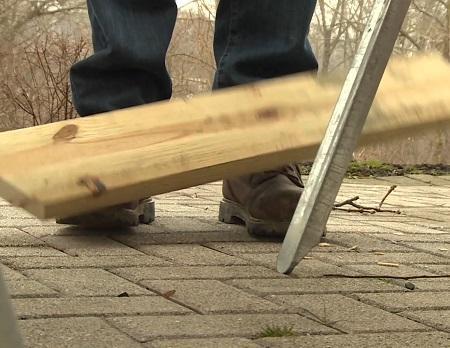Industrial and construction sites can be dangerous places, and one of the most significant hazards that workers face is the risk of being struck by an object. Whether it’s a falling tool or a piece of heavy machinery, being struck by an object can cause serious injuries or even death. In this article, we will take a look at the steps that construction companies and workers can take to protect themselves from struck-by hazards.
In this article we’ll take a look at 8 struck-by hazard safety tips:
- Identifying potential struck-by hazards. The first step in protecting yourself from struck-by hazards is to identify potential hazards on the job site. This includes assessing the work area for falling objects, such as tools or debris, as well as identifying areas where heavy machinery is in use. By identifying potential hazards, you can take steps to mitigate the risk of being struck by an object. It is important to identify potential hazards early and take the necessary steps to eliminate them. This includes conducting regular site inspections to identify and address any hazards that may arise. Additionally, it is important to provide the workers with the necessary training and equipment to recognize and avoid the hazards.
- Implementing safety protocols. Once potential hazards have been identified, it’s important to implement safety protocols to protect workers from being struck by an object. This includes using safety equipment such as hard hats and high visibility clothing, as well as providing training on how to safely operate heavy machinery and how to avoid being struck by an object. Safety protocols are critical in preventing workers from being struck by an object. It is important to ensure that all workers are aware of these protocols and that they understand the importance of following them. Additionally, it is important to provide the workers with the necessary equipment, such as hard hats, goggles, and vests, to protect them from the hazards.
- Using proper storage and handling techniques. Another key step in protecting yourself from struck-by hazards is to use proper storage and handling techniques for tools and equipment. This includes storing tools and equipment in secure locations, such as toolboxes or storage racks, and ensuring that heavy equipment is properly maintained and secured. Proper storage and handling techniques are critical in preventing workers from being struck by an object. It is important to ensure that the tools and equipment are stored in a secure location and that they are in good working condition. Additionally, it is important to provide the workers with the necessary training on how to properly handle and use the tools and equipment.
- Conducting regular inspections. Regular inspections of the job site can help to identify and address potential struck-by hazards. This includes checking for loose debris, damaged equipment, and other hazards that could cause an object to fall or strike a worker. Conducting regular inspections is an important step in preventing workers from being struck by an object. It is important to ensure that inspections are conducted regularly, at least once a day, or more frequently if needed, to identify and address any hazards that may arise. Additionally, it is important to document the results of the inspections and the actions taken to address any hazards found, to ensure that the site is always safe for the workers.
- Implementing traffic control measures. In areas where heavy machinery is in use, it’s important to implement traffic control measures to protect workers from being struck by a vehicle. This includes using barriers, signs, and flaggers to direct traffic and keep workers safely away from moving vehicles. Traffic control measures are critical in preventing workers from being struck by a vehicle. It is important to ensure that the traffic control measures are in place and clearly visible to the workers, and that they are followed at all times. Additionally, it is important to provide the workers with the necessary training on how to safely work in areas where heavy machinery is in use.
- Establishing a clear line of sight. One of the most important steps in protecting yourself from struck-by hazards is to establish a clear line of sight. This includes ensuring that workers have a clear view of the work area and that they are aware of the movement of heavy machinery and other equipment. By having a clear line of sight, workers can quickly react to potential hazards and avoid being struck by an object. A clear line of sight is critical in preventing workers from being struck by an object. It is important to ensure that the work area is well-lit and that the workers are aware of the movement of heavy machinery and other equipment. Additionally, it is important to provide the workers with the necessary training on how to safely work in areas where a clear line of sight may be obstructed.
- Communicating with coworkers. Effective communication is key to protecting yourself from struck-by hazards. This includes informing coworkers of potential hazards, such as the movement of heavy machinery, and using hand signals or other forms of communication to ensure that everyone is aware of their surroundings and the potential for being struck by an object. Communication is essential in preventing workers from being struck by an object. It is important to ensure that the workers are aware of any potential hazards and that they understand the importance of reporting any hazards or near-misses. Additionally, it is important to provide the workers with the necessary training on how to safely communicate with their coworkers, including the use of hand signals and other forms of communication.
- Developing an emergency response plan. In the event of an incident involving a struck-by hazard, it’s important to have an emergency response plan in place. This includes designating a team leader to coordinate response efforts, providing first aid training to workers, and having emergency contact information readily available on site. An emergency response plan is critical in preventing workers from being struck by an object. It is important to ensure that the emergency response plan is in place and that the workers are aware of it. Additionally, it is important to provide the workers with the necessary training on how to respond in the event of an emergency, including first aid training.
In conclusion, being struck by an object is a serious hazard that nearly all industrial and construction workers face on a regular basis. By identifying potential hazards, implementing safety protocols, using proper storage and handling techniques, conducting regular inspections, implementing traffic control measures, establishing a clear line of sight, communicating with coworkers and developing an emergency response plan, construction companies and workers can take the necessary steps to protect themselves from struck-by hazards. Employers should be aware of these steps and take the necessary steps to protect the workers from the hazards associated with construction sites.


